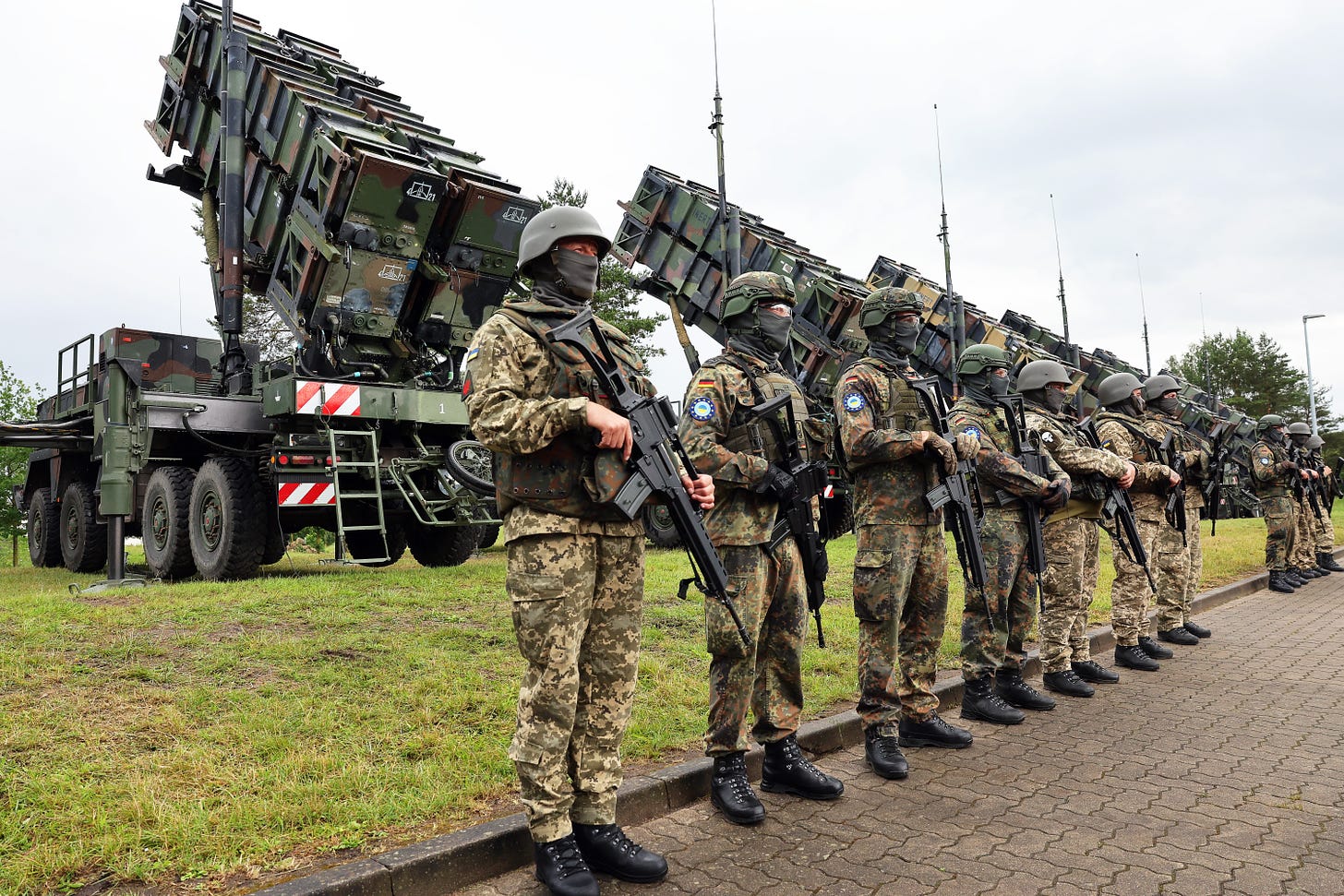
Ukraine Regains Momentum
The narrative of inevitable Russian victory is once again going up in smoke (and explosions).

WHAT A DIFFERENCE A FEW MONTHS MAKE. On February 21, the headlines warned, “War in Ukraine Is Turning in Putin’s Favor After Months of Stalemate.” Last week, they told a different story: “Putin Is Running Out of Time to Achieve Breakthrough in Ukraine.” Bloomberg News, source of both those headlines, reported in the newer piece that, while Russia had made “limited progress” when Ukraine was short on weapons, now that Western aid had started flowing Ukraine was halting the Russian offensive.
And thus the bad news/good news cycle about Ukraine enters another optimistic phase.
None of this comes as a surprise to many independent Russophone analysts, such as expatriate journalist Michael Nacke, who have been vocally skeptical of the recent narrative of Russian success and Ukrainian failure—particularly after the start of the Kharkiv offensive on May 10. Nacke has even joked that he wishes he had a “giant ‘I told you so’ mug.” As he put it in a recent stream:
This Bloomberg article is undoubtedly accurate because it reflects everything [open-source intelligence analyst] Ruslan Leviev and I have been telling you for months on this channel, even before the Kharkiv offensive: that the Russians don’t have enough hardware, the Russians don’t have enough manpower; that there is a certain window the Russian army has until weapons start being delivered to Ukraine, [and] that this window is being quite ineptly wasted.
Nacke also had some scathing words for Western journalists who keep falling for claims of Ukrainian doom and gloom and of Vladimir Putin riding high.
It now seems clear that Russia’s Kharkiv offensive, which caused a near-panic (or, in some circles, celebration) about an imminent collapse of the Ukrainian front and Russia’s imminent, major territorial gains, is a bust. After initial rapid advancement in border areas, the forward movement of Russian troops is stalled—and Ukrainians, with their new supplies of arms and munitions, are not only repelling Russian attacks but, in some cases, reclaiming lost ground. What’s more, while the Russian offensive in the Kharkiv region has been widely seen as a maneuver to force the Armed Forces of Ukraine to divert some of their troops from the Donetsk region and facilitate Russian gains there, no such gains have materialized. Overall, the Kharkiv offensive probably backfired by galvanizing Western material support for Ukraine. While the pessimistic narratives were no doubt demoralizing for many Ukrainians, they also sent a “Do something before it’s too late” message to NATO countries.
Here are a few developments in the war from just the past week:
A Ukrainian drone strike on a Russian air base deep inside Russian territory has reportedly taken out a Sukhoi Su-57 supersonic stealth jet, regarded as one of Russia’s most advanced fighter planes.
For the first time, a Ukrainian warplane has fired a missile that struck a target inside Russia, near Belgorod—a military command center reportedly responsible for units participating in the Kharkiv offensive. The anonymous analysts behind “Dosye Shpiona” (“Spy’s Dossier”), an often-cited Russian channel on the Telegram app, report that eight officers are “missing” after the attack. This is a direct result of the recent approval by Western governments, including the Biden administration, for Ukraine to use Western weapons provided to hit military targets inside Russian territory.1 The mayor of Kharkiv has already told Reuters that Ukrainian strikes at missile launch positions in Russia have reduced attacks on his city, buying it a “period of [relative] calm.”
Ukraine has struck an oil depot and other military targets in occupied Luhansk and (where Russian authorities are claiming, without evidence, that Ukraine targeted residential buildings) and has reportedly destroyed anti-aircraft systems in occupied Crimea.
Ukrainian troops are advancing in Vovchansk in the Kharkiv region, retaking parts of the city occupied by Russian troops in May, and successfully counterattacking and pushing back Russian forces in Lyptsi.
A Russian-language, pro-Ukraine commentator who blogs on Telegram as “Byt Ili” (“To Be Or”) welcomes the correction of the Western media’s bad-news narratives but also warn against excessive optimism and complacency: the blogger points out that the situation on the front “remains very difficult” for Ukrainian troops and that Russia continues to make small tactical gains in some areas. Such gains were recently reported in two small villages recaptured by Ukraine in last year’s counteroffensive: Robotyne in the Zaporizhzhia region and Staromaiorske in the Donetsk region. (While Russia claims complete capture of Staromaiorske, this has not been independently verified; meanwhile, Russian television has crowed about the supposed strategic significance of the village.) Russian troops are also reporting some successes near the town of Chasiv Yar, but considering that in mid-April Russian media were talking about a plan to seize the town in time for the May 9 Victory Day celebrations, things are clearly not going according to plan.
And it has continued to be true that Russian gains, such as they are, carry a staggering price in Russian lives. In a video published by Astra, a Telegram channel run by independent Russian journalists, a fully identified Russian contract soldier—Anton Andreyev from the 5th Company of the 1009th Regiment of the Russian Armed Forces—tells a harrowing story of the “meat storms” at Vovchansk. Andreyev says the soldiers were initially told that they would be stationed at the border but were then sent to attack the town with little preparation and no equipment except rifles and flak jackets, and ordered to keep going under heavy mortar fire. Losses—dead and wounded—amounted to half of the hundred-man company on the first night of the offensive; eventually, only twelve remained. Relatives of conscripts from the same regiment had complained in May about soldiers being threatened with treason charges for retreating when they were exhausted and ran out of ammunition. The independent Russian news site Verstka reports that around the same time, conscripts and reservists in detention for deserting or refusing to fight—including ones with physical or mental problems—were forcibly transported to combat zones and sent to fight.
Of course the lives of Ukraine’s defenders are also being tragically lost. But a new report from the independent Russian journalism project MediaZona, prepared in collaboration with the BBC Russian Service, shows that official Ukrainian claims of a vastly higher death toll on the Russian side may not be that far off, at least in those sectors of the front where Russia conducts “meat storms.” After analyzing casualties in the fighting at Bakhmut between July 2022 and May 2023, when the town fell to the Russians, the MediaZona/BBC investigation found that there were 19,526 deaths on the Russian side just in the ranks of the Wagner mercenary group (17,175 of them convicts). While the notorious late Wagner Group chief Yevgeny Prigozhin openly referred to the battle as the “Bakhmut meat grinder,” he insisted that the point was to “grind up” Ukrainian troops and that there were at least three times as many Ukrainian dead. The MediaZona/BBC number: 4,871, with another possible 630 whose date of death could not be determined. That’s approximately a 4:1 ratio—not even counting the dead from among the regular Russian troops, who also fought at Bakhmut.
FOR NOW, THE MOMENTUM SEEMS to be with Ukraine—not only on the frontlines, but in terms of international support. European countries are making more record pledges of aid to Ukraine. (It’s not clear whether the first ammunition deliveries from the Czech initiative have arrived in Ukraine yet; they were set to start this month.) The plan to send military instructors from NATO countries is being finalized. During a meeting with Ukrainian President Volodymyr Zelensky in Paris after the D-Day commemorations in Normandy, President Joe Biden not only pledged another $225 million in military aid but also apologized for the earlier delays caused by Republican obstructionism in Congress. And over the weekend, representatives from ninety countries, including forty-five heads of state, will attend the Ukraine peace summit, based on Zelensky’s peace proposals, in Obbürgen, Switzerland.
This doesn’t mean—even aside from Russia’s small and costly gains—that everything is sunny for Ukraine. It’s not clear, at this point, how successful Ukraine’s mobilization effort will be. (That said, for all the talk of its manpower advantage, Russia is currently press-ganging migrants and African exchange students into service in Ukraine.) Some promises of aid do not live up to their billing: While the first F-16s may finally arrive in Ukraine later this year, integrating them into the Ukrainian war effort may run into more complications, from the shortage of trained pilots to arcane rules regulating their use from different European countries.
Still, right now, Ukraine is successfully stopping and rolling back Russian aggression and cutting off Putin’s path to even a slow victory. It is also laying waste to the myth, assiduously promoted by the anti-Ukraine chorus in the West, that Russia can’t lose no matter how much aid the West gives Ukraine. The biggest danger to Ukrainian military and diplomatic success right now comes from the political success of antiliberal populists in Western democracies—be it Marine Le Pen in France or Donald Trump in the United States—who, should they come to power, are likely to hold Kyiv hostage to their agenda.















